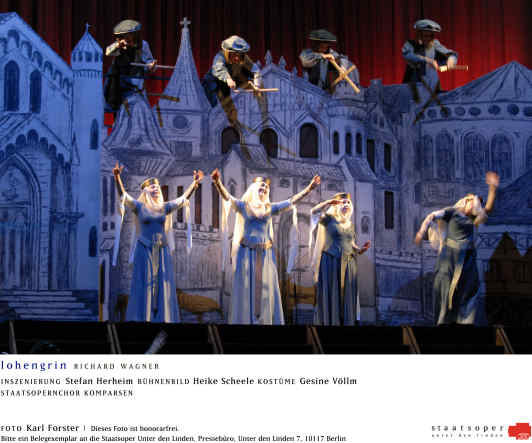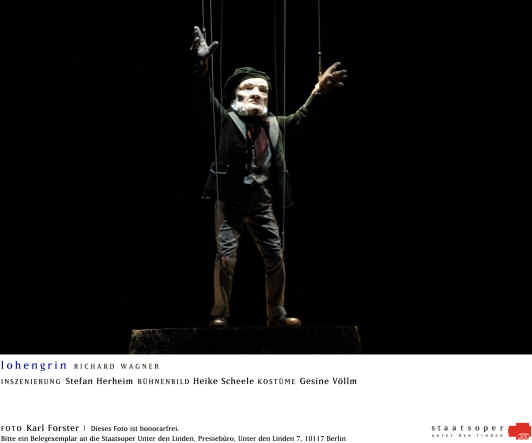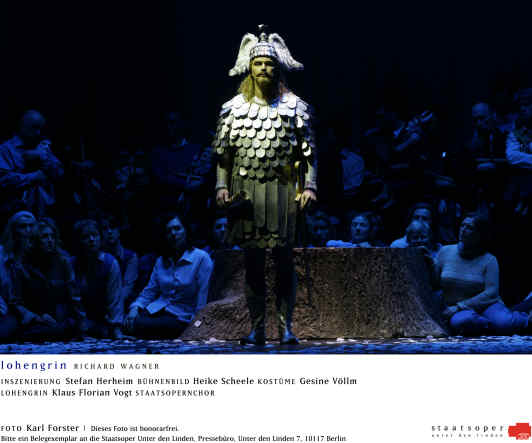Other Links
Editorial Board
-
Editor - Bill Kenny
-
Deputy Editor - Bob Briggs
Founder - Len Mullenger
Google Site Search
SEEN AND HEARD
UK OPERA REVIEW
Wagner, Lohengrin (new production):
Soloists, Staatsopernchor Berlin, Staatskapelle Berlin, Daniel Barenboim
(conductor). Staatsoper Unter den Linden, Berlin, 8.4.2009 (MB)
Cast:
King Henry the Fowler – Kwangchul Youn
Lohengrin – Klaus Florian Vogt
Elsa von Brabant – Dorothea Röschmann
Friedrich von Telramund – Gerd Grochowski
Ortrud – Michaela Schuster
The King’s Herald – Arttu Kataja
Production:
Stefan Herheim (director)
Heike Scheele (designs)
Gesine Völlm (costumes)
Olaf Freese (lighting)
fettFilm (video)
Throughout, the exterior manifestations of theatrical craft remind us of the
instrumentalisation at work. And at the end, we see Wagner’s own words, always
disregarded by his would-be protectors – remember, Protector is also the title
awarded by the king to Lohengrin in
At the heart, yet curiously and rightly decentred, was Klaus Florian Vogt’s
Lohengrin. This was a straightforwardly outstanding performance, following in
the footsteps – at least in my listening experience – of his
Erik and his
Walther. Strength and beauty of tone are brought together in a marriage of
heroic and lyric tenor. Has Vogt made a pact with the Devil? Might we at last
have found a Siegfried? Moreover, there was something quite terrifying about the
emptiness of his stage delivery, which, when married to such seductive means,
brought us closer than many would doubtless have liked, to a profoundly serious
confrontation both with ourselves and with our historical demons. Elsa was
powerfully portrayed by Dorothea Röschmann, occasionally a little strained, but
more usually with a tender, word-attentive lyricism. Her nobility was all the
more moving – and credible – for being tarnished by her brush with charismatic
power. Telramund and Ortrud, whilst far from being vindicated, are transformed
by the production into rather more complex figures than often they will appear.
In terms of performance, Gerd Grochowski was a Gunther-like figure, believable
in his weakness but perhaps a little lacking in strength as a real alternative
to Lohengrin. Michaela Schuster, on the other hand, was superb as an Ortrud
driven mad or madder by the unfolding events, events which chillingly excluded
her as an outsider. Her unhinged malevolence made no excuses but, as she spat
her contempt, we at least began to question why. As a force of ‘traditional’
normality, Kwangchoul Youn provided a firm, noble foundation as King Henry,
though we all know how swiftly charisma can sweep away traditional legitimacy;
the uncertainty of his rule of law was terrifyingly apparent. And the Herald’s
transformation from
Staatsopernchor Berlin (chorus master: Eberhard Friedrich)
Staatskapelle Berlin
Daniel Barenboim (conductor)

The Prelude to Act One, performed with magnificent luminosity by the
Staatskapelle Berlin, depicts Richard Wagner both as puppet and puppeteer, an
ambiguity to be revisited upon many of the characters. Apparently assumed into
heaven, a similar fate – albeit with an all-important distinction – will be
visited upon Lohengrin at the work’s conclusion. Wagner’s presence is seen on
stage throughout the work, sometimes in multiple guises, whether as puppets or
as chorus members – frockcoat, altdeutsch cap and all – and sometimes
melding with other members of the depicted Volk, both changing them and
being changed by them. Herheim’s treatment of the chorus is thought-provoking
throughout, taking advantage of what can in lesser hands seem like rather stock
responses to present a Volk dangerously swayed by the ministrations of a
charismatic leader and dangerous through its responses thereto. Losing their
individuality, as illustrated by their loss of individual modern dress, and
subsumed into a bland yet fearsome force of social repression, rejoicing in an
impossible, Magritte-styled Eden, followed by a make-believe world of horned
helmets and other neo-mediævalisms. The German catastrophe is unmistakeably
present. Heike Scheele’s Brabantian sets and Gesine Völlm’s costumes are here a
splendid riposte to those who actually claim to wish to see the vacuously
‘traditional’, which is of course nothing of the sort. For Lohengrin, when he
arrives, apparently straight from Neuschwanstein, is the menacingly kitsch
instrument of transformation from an opera house in modernto a world of fantasy. Gleichschaltung is the name of the game, as it was
once before under a seductive leader with nothing but emptiness for a core. We
can read what we want into him and that is part of the problem. Like his
creator, he will be assumed upwards but then, to seal the tragedy, will come
crashing back down to earth.


I mentioned Herheim’s virtuoso direction of the Volk-chorus. This would
have amounted to little, had it not been for a superb performance from its
members, very much back on form, as they had been in the
previous night’s Ein deutsches Requiem. The Staatskapelle Berlin was
on equally excellent form, this music playing to its ‘old German’ strengths,
although Herheim’s production of course rightly problematises the very concept
and reminds us of the orchestra’s modernity, including its fine record under
Daniel Barenboim and others in contemporary music. Barenboim was perhaps not on
quite the form to which Wagner can often bring him. There were a few
shortcomings to his conducting, for instance, a conclusion to the first act in
which he ran away with the orchestra, apparently leaving the chorus to fend for
itself. But on the whole, the score was in sure hands, with a conductor who
brought out not only the golden (Lohengrin-like?) string tone but equally a
frightening vision of madness in the brass fanfares of the third act, in which
orchestra, conductor, and director worked together to convey the terrors of
totalitarian militarism, especially that with a benign face. Such is a powerful,
if all too rare, example of how musical drama can and should work.
Mark Berry
Pictures © Karl Foster
Back
to Top
Cumulative Index Page
